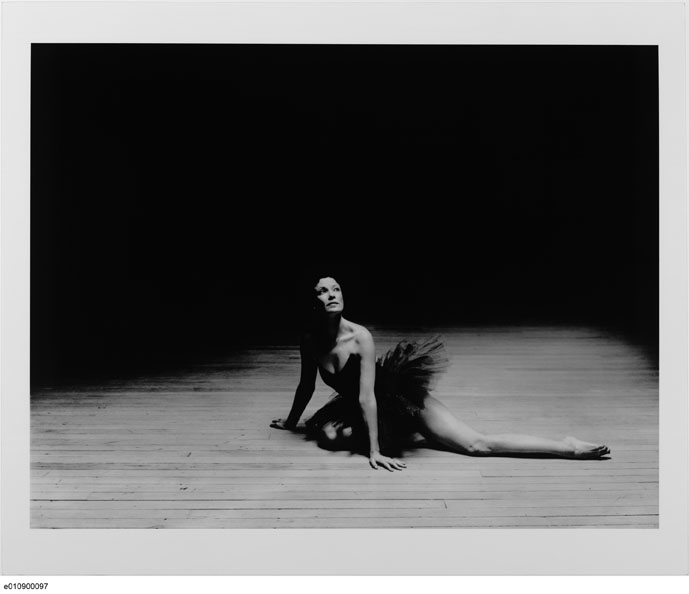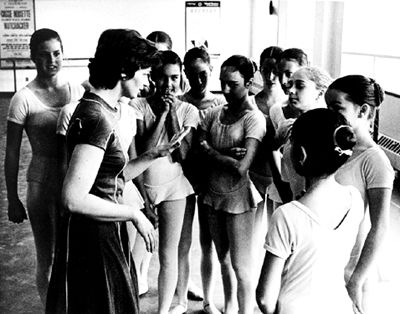Karen Alexandria Kain, CC, OOnt, dancer, artistic director, arts administrator (born 28 March 1951 in Hamilton, ON). Karen Kain is one of Canada's finest and most internationally renowned dancers. In her 28 years as a dancer with the National Ballet of Canada (NBC), she won renown for her strong technique, breadth of movement, sensitive musicality, daring attack and versatile dramatic ability. Her repertoire spanned both classical and contemporary works, including all the major full-length ballerina roles and a range of leading roles in shorter works. She continued working with the NBC beyond her retirement as a ballerina; she served as the company’s artistic director from May 2005 until January 2021 and is now artistic director emeritus. She is a Companion of the Order of Canada, an Officer of the Ordre des Arts et des Lettres de France, and a Member of the Order of Ontario and Canada’s Walk of Fame. She has received a Governor General’s Performing Arts Award for Lifetime Artistic Achievement and numerous other honours.

Early Life and Education
Karen Kain was born in 1951 in Hamilton, Ontario, the oldest of four children. When she was six, her mother enrolled her in ballet school. Three years later, in 1962, she began training at the National Ballet School of Canada, which at the time was run by Betty Oliphant. Kain attended the school on a partial scholarship.
Early Career
In 1969 at age 18, Karen Kain was offered a contract with the National Ballet of Canada by the founder and artistic director, Celia Franca. In January 1971, Kain made her debut in the challenging role of the Swan Queen in Swan Lake. Also in 1971, she was promoted to principal rank within the company and first danced with Frank Augustyn in Intermezzo, directed by Eliot Field. Kain and Augustyn would go on to dance together in many acclaimed performances.
In 1973, Kain won the women’s silver medal and, with Augustyn, the prize for the best pas de deux at the Moscow International Ballet competition. Rudolf Nureyev, the great Soviet-trained dancer who had staged The Sleeping Beauty for the company in 1972, took a special interest in Kain and Augustyn. He helped accelerate their rapid ascent to fame as Canada’s favourite dance partnership. They came to be known as “the gold-dust twins.” Kain also appeared frequently with Nureyev in guest engagements around the world. From 1973 to 1984, she toured internationally with him, appearing in ballets such as The Sleeping Beauty and Swan Lake.
National and International Success
Karen Kain’s strong technique, breadth of movement, sensitive musicality, daring attack and versatile dramatic ability were evident in both classical and contemporary works. During her 28 years of dancing with the National Ballet, she built an exceptionally large repertoire; it included all the major full-length ballerina roles and a wide range of leading roles in shorter works. Much taller than an average ballerina at 5’7, she infused such traditional roles as Aurora in The Sleeping Beauty, the Swan Queen in Swan Lake and the title role in Giselle with personal distinctiveness. She brought heartbreaking intensity to John Cranko’s Romeo and Juliet and a vivid sense of romantic comedy to Frederick Ashton’s La Fille mal gardée.
From early in Kain’s career, choreographers were eager to create roles for her. Beginning in 1974, she performed for almost a decade as a guest artist for the Ballet National de Marseille under Roland Petit. However, Kain’s loyalties were firmly entrenched in Canada and the National Ballet. This helped endear her to the public and made her a household name in Canada. With her home company, she created a steady stream of roles in ballets: Ann Ditchburn’s Mad Shadows; Constantin Patsalas’s Rite of Spring, Sinfonia and Oiseaux exotiques; Glen Tetley’s Alice, La Ronde and Tagore; John Alleyne’s Time Out with Lola; Christopher House’s Café Dances; John Neumeier’s Now and Then; and Dominique Dumais’s Tides of Mind. Kain also forged a particularly strong creative relationship with James Kudelka; she originated roles in The Rape of Lucrece, Musings, The Miraculous Mandarin, Spring Awakening and The Actress.

Retirement from the Stage
Karen Kain’s performing career lasted well beyond the norm for ballerinas. She relinquished major roles to which she felt she was no longer suited; but her dancing beyond age 40 blossomed into new dimensions of creativity, dramatic complexity and emotional depth. Nevertheless, in 1996, she announced her intention to retire as a full-time principal dancer with the company. This prompted Garth Drabinsky to produce a cross-Canada farewell tour in the summer and early fall of 1997. Kain continued to dance for another year, frequently with the senior company of Nederlands Dans Theater, and in a variety of galas.
Artistic Director of the National Ballet of Canada
Karen Kain accepted Artistic Director James Kudelka’s invitation to rejoin the National Ballet in 1998 as artist-in-residence. Her role was expanded to that of artistic associate in 1999. She reappeared on stage as Lady Capulet in Romeo and Juliet. But otherwise, she focused her efforts on coaching the dancers; staging select works from the repertoire; fundraising; and contributing generally as a member of the senior executive management team.
When Kudelka abruptly resigned in May 2005, Kain was soon named as the new artistic director. Some of the most acclaimed and memorable productions under her leadership include: Christopher Wheeldon’s Polyphonia (2007) and The Winter’s Tale (2015); Alexei Ratmansky’s Romeo and Juliet (2011); Kevin O’Day’s Hamlet (2012); Kenneth MacMillan’s Manon (2014); and John Neumeier’s Nijinsky (2013). Kain marked her 50th anniversary with the company by making her directorial debut with a restaging of the Erik Bruhn production of Swan Lake. (Originally slated for June 2020, the production was rescheduled to June 2021 due to the COVID-19 pandemic.)
In October 2019, Kain announced that she would be retiring from her position as artistic director in January 2021. Upon stepping down, she was named artistic director emeritus. The National Ballet enjoyed great success during her tenure. It completed 23 international tours and commissioned 24 new works. The company also raised $104 million through fundraising campaigns and operated with a surplus in 10 of her 14 years as artistic director.
Onscreen Appearances
Karen Kain’s celebrity was reinforced by frequent television specials and other appearances. She starred in Norman Campbell’s TV productions of Giselle, La Fille mal gardée, The Merry Widow, La Ronde and Alice. She has been the subject of several documentaries, including Anthony Azzopardi’s Making Ballet, based on The Actress, and David Langer’s CBC Life and Times documentary, also based on The Actress. She was also the focus of Veronica Tennant’s Karen Kain: Dancing in the Moment for CBC TV. It won an International Emmy Award in 1999.
Community Involvement
Karen Kain has worked in a voluntary capacity for a variety of charitable organizations and public institutions; they include the Kidney Foundation, the Toronto Humane Society and Foster Parents Plan Canada. Notably, she is founding president of the Dancer Transition Resource Centre. It helps dancers plan for and accomplish a smooth transition from stage performance to a new career. Kain acted as chair of the board of the Canada Council for the Arts from 2004 to 2008. The Karen Kain School of the Arts, so named by Toronto elementary school children to honour her career-long contributions to the arts, opened in 2008 in Etobicoke, Ontario.
See also Dance; Dance Education; Ballets and Dance Theatre; Dance and the Media; Founding of the National Ballet of Canada.
Honours and Awards
- Officer, Order of Canada (1976)
- Member, Order of Ontario (1990)
- Companion, Order of Canada (1991)
- Performing Arts Award, Toronto Arts Awards (1992)
- Cartier Lifetime Achievement Award (1996)
- National Arts Centre Award, Governor General's Performing Arts Awards (1997)
- Canada’s Walk of Fame (1998)
- Officier de L'Ordre des Arts et des Lettres, Government of France (2002)
- Lifetime Artistic Achievement (Dance), Governor General's Performing Arts Awards (2002)
- Queen Elizabeth II Golden Jubilee Medal (2002)
- Barbara Hamilton Memorial Award (2007)
- Distinguished Artist Award, International Society for the Performing Arts (2011)
- Queen Elizabeth II Diamond Jubilee Medal (2012)
- The Peter Herrndorf Arts Leadership Award (2016)
- Queen Elizabeth II Coronation Award, Royal Academy of Dance (2019)
- Featured in Legends of Canadian Ballet permanent stamp series, Canada Post (2021)
Honorary Degrees
- Doctor of Letters, York University(1979)
- Doctor of Laws, McMaster University (1979)
- Doctor of Laws, Trent University (1982)
- Doctor of Letters, University of British Columbia (1988)
- Doctor of Laws, Brock University (1990)
- Doctor of Laws, University of Toronto (1993)

 Share on Facebook
Share on Facebook Share on X
Share on X Share by Email
Share by Email Share on Google Classroom
Share on Google Classroom






